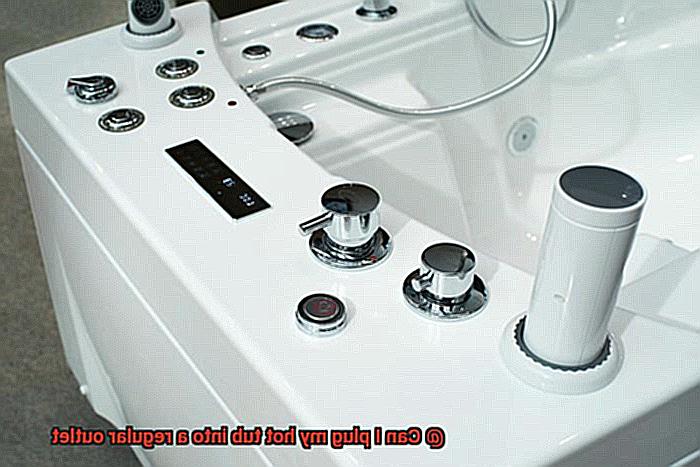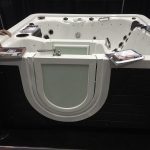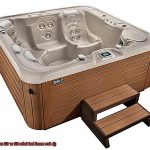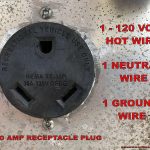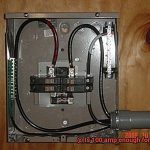Close your eyes and picture this – a crisp evening, the warm steam of a bubbling hot tub, and the clink of champagne glasses. Ahh, pure relaxation. Hot tubs have become a must-have for many homeowners, offering unparalleled relaxation and stress relief. But before you jump into your hot tub oasis, there’s one crucial question you need to ask yourself: can I plug my hot tub into a regular outlet?
At first glance, it may seem like plugging your hot tub into any old outlet should do the trick. However, unlike your everyday appliances or electronics that use minimal power, hot tubs require a substantial amount of electricity to function safely and efficiently. Attempting to plug your hot tub into a standard outlet can result in disastrous consequences such as damage to the unit, short circuits, or even electrocution.
So what’s the verdict? Can you plug your hot tub into a regular outlet? The answer is unequivocally no. Hot tubs require their own dedicated circuit breaker and electrical connection specifically designed to handle high voltage demands. Even if it seems like a regular outlet could handle the required voltage, it’s not recommended due to safety concerns.
In this post, we’ll explore in-depth why using a regular outlet for your hot tub is not an option and what practical alternatives are available for safe and efficient use of your beloved relaxation haven. So buckle up and let’s dive deeper.
Contents
What is a Regular Outlet?
Before you take the plunge, it’s important to understand the electrical requirements needed to operate it safely. One common question that arises is whether or not you can plug a hot tub into a regular outlet. The answer is no, but let’s explore why.
When we talk about a “regular outlet,” we’re referring to the standard 120-volt electrical outlet found in most homes. These outlets are great for everyday use with smaller appliances like lamps and chargers. However, hot tubs require a lot more power than what these outlets can provide. Most hot tubs need either a 240-volt or 120/240-volt circuit, depending on their size and specific electrical requirements.
Trying to plug your hot tub into a regular outlet can lead to disastrous consequences. It can overload the circuit and cause it to trip or even start an electrical fire. Not only can this damage your hot tub, but it can also pose a significant risk to the safety of you and your loved ones.
To make sure that your hot tub is installed correctly and safely, it’s essential to seek help from experts in the field. A licensed electrician or the manufacturer of your hot tub should be consulted to determine the appropriate electrical requirements for your specific model. This will ensure that your hot tub is installed safely and operates at its best.
Can You Plug a Hot Tub into a Regular Outlet?
It’s a common question, but the answer isn’t as simple as a yes or no. There are several factors to consider before connecting your hot tub to an outlet.
One of the most important factors is voltage and amperage requirements. Most hot tubs require a 240-volt electrical supply, which regular outlets cannot provide. Regular outlets usually supply only 120 volts, which is not enough for most hot tubs. Plugging your hot tub into a regular outlet can overload the circuit and cause electrical problems, creating serious safety hazards.
It’s also essential to consider the wiring in your home. If your home’s wiring is outdated or not up to code, plugging your hot tub into a regular outlet can cause serious electrical issues. To avoid these problems, it’s crucial to consult with an experienced electrician before attempting to plug your hot tub into any outlet.
So, what’s the best course of action? Always seek advice from experts in the field, such as licensed electricians or hot tub manufacturers. They can assess your needs and advise on the safest way to install and use your hot tub.
The Dangers of Plugging a Hot Tub into a Regular Outlet
Hot tubs are a luxurious and relaxing addition to any home, but it’s crucial to understand the dangers associated with plugging one into a regular outlet. Regular outlets are not designed to handle the amount of power that a hot tub requires, which can lead to several potential hazards.
One of the most significant risks of plugging a hot tub into a regular outlet is electrical shock. Overheating and short circuits can occur when an outlet is overloaded, leading to electrocution. This risk is even more concerning in wet environments, such as those surrounding hot tubs. To avoid this hazard, it’s vital to use the proper electrical setup during installation.
Another danger to be aware of is the potential for a fire to start. Hot tubs draw a considerable amount of power, and regular outlets are not equipped to handle this load. As a result, wiring can overheat and potentially start a fire, causing significant damage to your home. This risk can be avoided by hiring a licensed electrician to install a dedicated circuit and breaker designed specifically for your hot tub’s power needs.
Using a regular outlet for your hot tub can also cause damage to your home’s electrical system over time. The constant strain on the wiring can lead to wear and tear, which can result in costly repairs down the line. Additionally, using a regular outlet instead of the proper electrical setup may void your homeowner’s insurance policy. Most policies require that any electrical work be done by a licensed electrician, and using a regular outlet instead can be considered an act of negligence.
Alternatives to Plugging a Hot Tub into a Regular Outlet
Hot tubs are the ultimate relaxation experience, but plugging them into a regular outlet can be risky business. Luckily, there are alternatives to consider that will keep you and your home safe.
Option number one is installing a dedicated circuit for your hot tub. This involves hiring an electrician to install a new circuit that can handle the higher voltage and amperage requirements of your hot tub. Though it may be more expensive, it ensures that your hot tub receives the proper electrical supply and reduces the risk of any electrical issues or damage to your home’s electrical system.
Option number two is using a plug-in spa pack. These are specifically designed for hot tubs and provide an easy and safe way to connect your hot tub to a regular outlet. Equipped with a GFCI, they come with added protection against electrical hazards such as electrocution. Installing these packs is relatively easy and can be a cost-effective solution for those who don’t want to hire an electrician or make major modifications to their home’s electrical system.
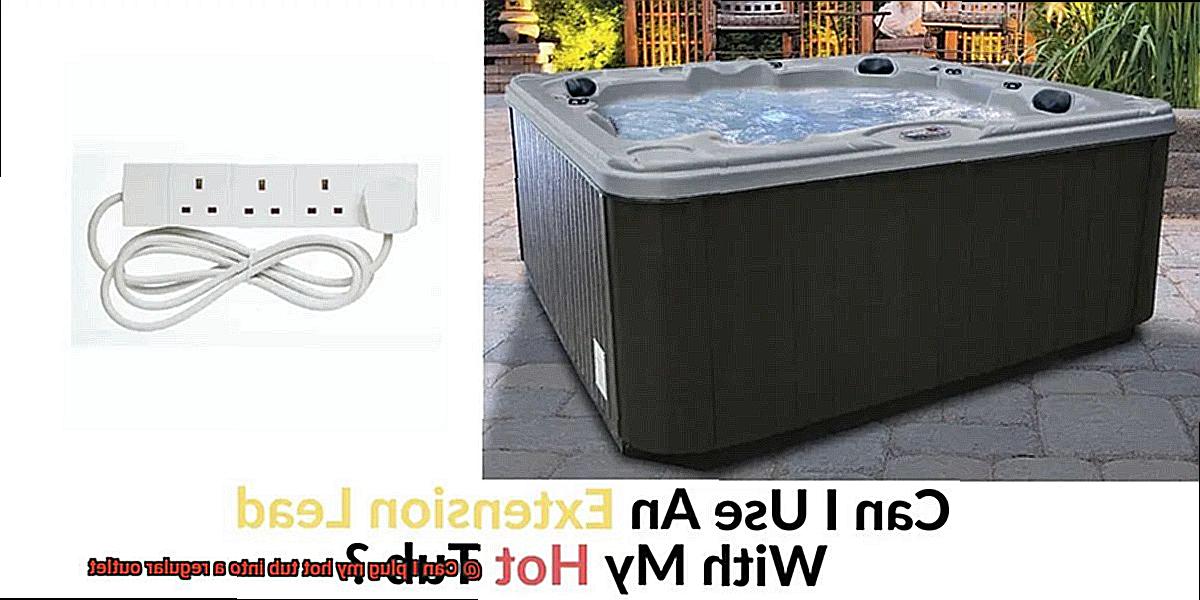
Finally, option number three is using a low-voltage hot tub. These operate on 110-120 volts, which is the same voltage as a regular household outlet. Although they may not be as powerful as high-voltage hot tubs, they still offer an enjoyable and relaxing experience. Moreover, low-voltage hot tubs are typically more energy-efficient, saving you money on electricity bills.
It’s important to note that not all hot tub models offer this option, so it’s best to consult with a professional before making a purchase.
Electrical Requirements for Plugging in a Hot Tub
But before you can immerse yourself in its warmth and relaxation, it’s essential to understand the electrical requirements for plugging in a hot tub. Hot tubs require a dedicated circuit, meaning the circuit is solely for the hot tub and cannot be shared with any other electrical devices. Most importantly, trying to plug your hot tub into a regular outlet is not only dangerous but can also cause major damage to your hot tub.
To ensure that your hot tub is safely and correctly installed, it’s essential to consult with an expert in the field – a licensed electrician. An electrician can assess your home’s electrical system, determine if it’s up to code, and make any necessary upgrades or repairs.
For example, they may need to install a GFCI (Ground Fault Circuit Interrupter) breaker for safety purposes, which will shut off the power if there is an electrical issue.
Hot tubs also require specific voltage and amperage. Most hot tubs require 240 volts and at least 50 amps, which means that your electrical system may need to be upgraded to accommodate the hot tub.
Additionally, the wiring must be of a sufficient gauge to handle the high amperage requirements of the hot tub.
It’s crucial to note that attempting to plug in a hot tub into a regular outlet can not only damage your hot tub but can also pose a serious safety hazard. Don’t risk electrocution or fire – always consult with a licensed electrician before attempting to plug in your hot tub.
GFCI Protection for Safety Reasons
If so, it’s important to understand the safety risks associated with electrical devices near water sources. Fortunately, there’s a simple solution: GFCI protection. Here are five reasons why GFCI protection is essential for hot tubs and other outdoor electrical devices.
Prevent Accidents
GFCI protection quickly shuts off power if there’s an imbalance in the electrical current. This is especially important for hot tubs near water sources, as even a small shock can be dangerous or deadly. By preventing electrocution, GFCI protection can help keep you and your loved ones safe while enjoying your hot tub.
Building Codes Require It
Many building codes require GFCI protection for all outdoor outlets. So, if you want to plug your hot tub into a regular outlet outside, it must have GFCI protection. Failing to comply with building codes could result in costly fines or even legal action.
Not All Outlets Are Protected
It’s important to note that not all outlets are GFCI-protected, even if they’re located near water sources. If you’re unsure whether an outlet is protected, it’s best to consult with a licensed electrician or use a GFCI tester to check the outlet yourself. Don’t take any chances with your safety.
Regular Testing Is Essential
GFCI protection should be tested regularly to ensure it’s functioning properly. If the protection fails the test, it should be repaired or replaced immediately. Testing your GFCI protection only takes a few minutes and could save your life.
Proper Installation and Maintenance Are Essential
Proper installation and maintenance of all electrical components of the hot tub are essential for safety. This includes checking for frayed wires, loose connections, and any signs of damage or wear.
By ensuring that your hot tub is properly installed and maintained, you can enjoy all the benefits of this relaxing and therapeutic experience without compromising your safety or the safety of others.
XLOI-rEO_0s” >
Conclusion
In conclusion, a hot tub can be the ultimate relaxation and stress-relief tool for your home. However, it’s crucial to prioritize safety when dealing with electrical requirements. While plugging your hot tub into a regular outlet may seem like an easy solution, it can lead to disastrous consequences such as damage to the unit, short circuits, or even electrocution. The answer is unequivocally no.
Hot tubs require their own dedicated circuit breaker and electrical connection specifically designed to handle high voltage demands. Seeking help from experts in the field such as licensed electricians or hot tub manufacturers is essential to determine the appropriate electrical requirements for your specific model. This will ensure that your hot tub is installed safely and operates at its best.
But don’t worry. There are alternatives available that will keep you and your home safe while still allowing you to enjoy all the benefits of a hot tub. Installing a dedicated circuit for your hot tub, using a plug-in spa pack or low-voltage hot tub are all viable options that won’t compromise safety.
Remember: GFCI protection is essential for all outdoor outlets near water sources such as hot tubs. It quickly shuts off power if there’s an imbalance in the electrical current and prevents electrocution. Testing GFCI protection regularly and ensuring proper installation and maintenance of all electrical components of the hot tub are also crucial for safety.
So, by following these guidelines and consulting with professionals before attempting any installation or modification of your home’s electrical system, you can enjoy all the benefits of this relaxing and therapeutic experience without compromising safety.

